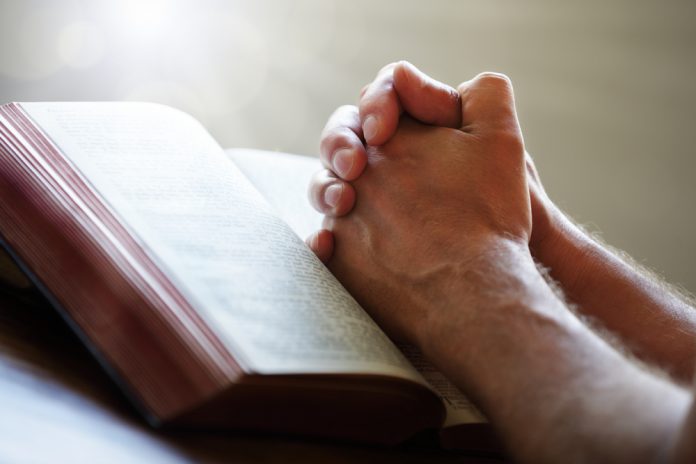
by Eric Ruszala
“How much can we really do with an hour a week?” laments the parish program catechist. “There’s so much to teach. Where do I start?”
Start with prayer!
No part of any curriculum is more important than prayer. If I teach my students everything there is to know about the Catholic faith but have not taught them to be aware of God, to go to God, to talk to God, and to listen to God, I have failed as a catechist.
Model What You’ve Been Taught
Education experts say that most teachers teach the way they have been taught. In my case, learning by example has been a blessing.
Throughout my years of Catholic education—as a student and a teacher—I’ve seen modeled almost every form of Christian prayer. Sister Joan in eighth grade, for example, pulled out her hymnal and coaxed an awkward group of teens to raise their voices to the Lord in song. Mr. Wagner, my high school biology teacher, led us in the same prayer before every test—one that I memorized and use with my students today. Mrs. Sinda, my fifth-grade teacher, led us in call-and-response prayers that affirmed our goodness as children of God with a mission.
How can you jump-start the prayer life in your classroom? Pray. Pray with every class you teach, even multiple times during class.
Conversation and Presence
Prayer isn’t only for once a day or once a week. Prayer is an ongoing conversation with God. When students arrive at my door, we pray. Praying is a great way to focus students when they walk into your room; it prepares them for what lies ahead.
Be sure your prayer is authentic. Don’t shuffle through items on your desk, glance at the clock, or think about your lesson plan while you or a student leads prayer.
Don’t begin prayer until the class is ready. Say, “Let’s remind ourselves that we’re in God’s presence” (not “Let’s place ourselves in God’s presence”—for we certainly do not shift ourselves in and out of the presence of the Divine). Wait for silence. Then begin.
Forms of Prayer with Students
I have used a variety of prayer forms with my students: spontaneous prayer, intercessory prayer, scriptural prayer, prayer using texts from the Liturgy of the Hours or the Sacramentary, prayer with and to the saints, prayer with music. (Yes, it takes some guts to sing, especially in front of older kids. And yes, it takes a certain comfort level to get them to sing with you, but if they think of it as prayer and not performing, it can be done—and they love it.)
Once a month, my eighth-grade class does a guided meditation based on the Sunday readings. Students relax, close their eyes, and place themselves into the words and actions of Scripture. When students are unfocused and your efforts to calm them are not working, let the Holy Spirit handle it for you.
Don’t be afraid to use the traditional prayers of the Church. But as they grow older, students should know the words to these prayers and what the words mean. Pray. Don’t simply “say” prayers.
Prayer: The Gift You Give
When you pray with your students, you send them a powerful message: Prayer is an essential part of a life of faith. When you introduce to your students a wide variety of prayer forms, you give them a great gift. They can choose the prayer forms that lead them closer to God in their own personal lives. They’ll thank you someday. Even better, they’ll thank God.
Seasonal Prayer in the Classroom
During Ordinary Time, I often begin prayer with one of the ancient greetings: “Blessed be the name of the Lord” or “Praised be Jesus Christ,” and the students know to respond “Now and forever.”
During Lent, I end every prayer with the acclamation familiar to us from the Stations of the Cross: “We adore you, O Christ, and we praise you,” and the students respond, “For by your holy cross, you have redeemed the world.”
On saints’ feast days, I read a short biography of the saint, and we call upon the saint and our personal patron saints and parish and school patron saints to pray for us.
During the Easter Season, an Alleluia follows every Amen, and a “paschal” candle stands at the front of our classroom. Thus, connections are made to the liturgy of the Church.
Eric Ruszala is a certified catechist and director of religious education through the Archdiocese of Detroit. He is the Confirmation coordinator and a middle-school catechist at Our Lady of Hope Parish in St. Clair Shores, MI.
Check out ruwix.com to learn the solution of the Rubik’s Cube and other twisty puzzles like Pyraminx, Square-1 etc.
Copyright 2011, Bayard, Inc. All rights reserved. This article is protected by United States copyright and other intellectual property laws and may not be reproduced, rewritten, distributed, redisseminated, transmitted, displayed, published or broadcast, directly or indirectly, in any medium without the prior written permission of Bayard, Inc.
This article was written by the Catechist Staff and appeared in Catechist magazine, September 2011.
Image Credit: Brian A Jackson/Shutter Stock 145450387




